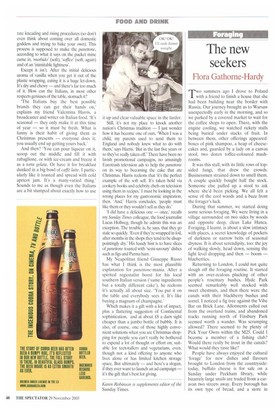The new seekers
Flora Gathorne-Hardy
Two summers ago I drove to Poland 1 with a friend to finish a house that she had been building near the border with Russia. Our journey brought us to Warsaw unexpectedly early in the morning, and so we parked by a covered market to wait for the coffee shops to open. There, with the engine cooling, we watched rickety stalls being buried under stacks of fruit. In between them, other offerings appeared: boxes of pink shampoo, a heap of cheesecakes and, guarded by a lady on a canvas stool, two dozen toffee-coloured mushrooms.
It was this stall, with its little rows of lopsided fungi, that drew the crowds. Businessmen strained down to smell them. A couple quickly bought half the stock. Someone else pulled up a stool to ask where she'd been picking. We all felt a sense of the cool woods and a buzz from the forager's luck.
During that summer, we started doing some serious foraging. We were living in a village surrounded on two sides by woods and opposite deep, clean Lake Hanca. Foraging, I learnt, is about a slow intimacy with places, a secret knowledge of pockets of darkness or narrow belts of seasonal dryness. It is about serendipity, too: the joy of walking slowly, head down, sensing the light level dropping and then — boom — blueberries.
Returning to London, I could not quite slough off the foraging routine. It started with an over-zealous plucking of other people's rosemary bushes. Hyde Park seemed remarkably well stocked with sweet chestnuts, and then there were the canals with their blackberry bushes and sorrel. I noticed a fig tree against the Vibe Bar on Brick Lane. Allotments called out from the overland trains, and abandoned tracks running north of Finsbury Park seemed worth a wander. Was scrumping allowed? There seemed to be plenty of Pick Your Owns within the M25. Could I become a member of a fishing club? Would there really be trout in the canals? What would they taste like?
People have always enjoyed the cultural 'forage' for new dishes and flavours brought to London from the countryside: today, buffalo cheese is for sale on a Sunday under Peckham library, while bizarrely large snails are traded from a caravan two streets away. Every borough has its own type of bread, and a store in Hammersmith stocks vodka containing a meadow grass that wild European bison feed on.
Real foraging is even more satisfying. All around us in London are the indigenous and exotic plants that have taken root in the city, tapping down into the buried tributaries of the Thames. For the forager, the A-Z is a map of a different city altogether. The roads sink into insignificance, and the pockets of wasteland attract the highlighter pen: allotments, curious dots of old orchards and common lands, the ghosts of ancient woodland such as Theydon Bois. I marked municipal mulberry bushes with stars and the Lea Valley deserved a whole mess of post-it notes, as did Epping Forest. And then there are people's gardens. Robin Leigh-Pemberton, the former governor of the Bank of England, kept a hive or two on the building's roof, and the yield was impressive. How would it be possible to forage for this harvest of blossom, apples, sage, vines, crab apples, rose hips, hawthorn and camomile behind the garden walls?
The foraging search adds so much to urban living. There is a deep satisfaction in roasting chestnuts at the fireside that a candlelit dinner only touches upon. And I love the way blackberry bushes stop conversations and send people drifting off on their greedy, slow pick.
There are difficulties for the forager in discerning between the palatable and the unpalatable, and in avoiding the deadly in disguise. Few people know where to look, what to choose and what to reject, and the 20 generally poisonous mushrooms are not so different from the 20 most delicious. Then there are the added problems of pollution and the contamination of soil and plants. It may be possible to get oysters and salmon from the Thames, mushrooms from Primrose Hill and rabbits from Epping warrens, but most people prefer the idea of food grown or picked in the countryside.
So, is there a future for foraging in London? I am bound to say yes, because it reveals the heartbeat of nature still thumping in the capital. Even just snatching a pear from a canal-side tree brings back a sense of the seasons. There are more than 20 varieties of apple local to London — the Hounslow Wonder and the Merton Joy are just two of them. Foraging brings reservoirs and common orchards off the map and back into daily life. It makes us think about where our food has come from and encourages us to become curious about visiting these places. It may even prompt us to start searching in the town for places where land could be brought back into use for wild foods.
In the end, most of the pleasure of foraging has always been vicarious. The businessmen in Warsaw savoured the smell of the mushrooms and were carried back in their minds to the mysteries of the woods, even though their days were spent in a skyscraper office. The box of vegetables arriving from Kent with a newsletter tells you about a surprisingly wet week. A connection is made: there is delight in knowing that the ground is wet out there.



























































































 Previous page
Previous page